Jim’s heart surgery this week went well!!! He’ll be in intensive care for a few days. No phones there etc. Will know more in a couple of days.
Prior to his medical emergency, Jim provided us with this weeks column – and we are posting it according to his wishes. Jim does not use social media – but he will see this post, so if you’d like to send a message please place it in the comments below.
Speedy recovery, Jim. – Jerry Beck
Suspended Animation #411
Mike Gabriel co-directed The Rescuers Down Under (1990) and Pocahontas (1995). He began his career at Disney as an assistant animator on The Fox and the Hound (1981).
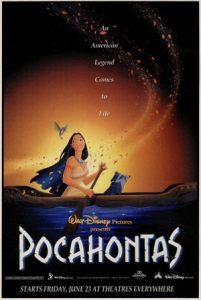 In 2004, he directed the Oscar nominated short Lorenzo about a cat dancing with its tail. For the short, he designed the characters, storyboarded the film, painted all the backgrounds, and was responsible for the production design.
In 2004, he directed the Oscar nominated short Lorenzo about a cat dancing with its tail. For the short, he designed the characters, storyboarded the film, painted all the backgrounds, and was responsible for the production design.
He works for Walt Disney Animation in a variety of capacities including director, animator, storyman, character designer, visual development, production designer and art director.
Some readers may be unaware that earlier in my life, I earned a living as a professional actor in Los Angeles doing voice-over work, stage and television. I developed a pretty extensive and impressive resume but it was hard work.
One of the most important tools for an actor in Los Angeles was Drama-Logue, a weekly newspaper with casting listings. It also included ads, interviews, articles and more. Most issues were just casually tossed after sending out head shots and resumes for potential jobs.
In a storage box, I recently found a copy of the June 15-21, 1995 edition that included an interview with Mike Gabriel. Here is an excerpt that hasn’t been seen in twenty-seven years.
Gabriel: “I had just finished co-directing my first animated feature for Disney and I was a little surprised at how arduous these are to make. For the next one I wanted specific things in it that I really loved.
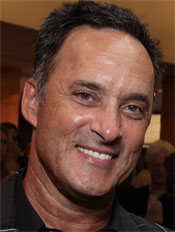
Mike Gabriel
“I know the Eisner-Katzenberg regime loved the fish-out-of-water story. We had John Smith from a whole other land. When I pitched it, Michael Eisner immediately sparked up. ‘That’s it!’ He knew a lot about it. I guess he was working on Disney’s America in Virginia. I didn’t even know about the project.
“I grew up with a burning desire to draw Disney animated features. I took every rejection as a cue to push myself harder. Now that I am a director, I miss the days of working in the trenches, developing characters. On Pocahontas, at first I went back to coming up with ideas for the film.
“A fellow named Joe Grant and I started drawing every day. He is 87. He was Walt’s right hand man on Fantasia and Dumbo. He started in 1933 at the company and was head of the model department back in the 1930s and 1940s. He left in about 1950 and came back about six years ago. He and I had hit it off working on Swan Lake which is hitting a bit of a road block.
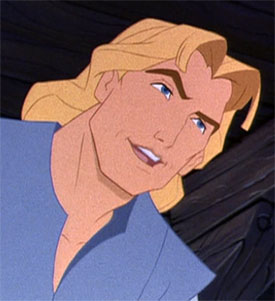 “We are simpatico and he immediately liked the idea of Pocahontas so we started drawing little dogs that the villain would have. Then we thought of what Pocahontas would have so he drew a raccoon sitting on a stump and a cob of corn on his head and Pocahontas was trying to shoot it off. So it is a lot of fun at that stage.
“We are simpatico and he immediately liked the idea of Pocahontas so we started drawing little dogs that the villain would have. Then we thought of what Pocahontas would have so he drew a raccoon sitting on a stump and a cob of corn on his head and Pocahontas was trying to shoot it off. So it is a lot of fun at that stage.
“It definitely influences our animated character by who is doing the voice. There are sessions of video recording to check their eye expressions and what their acting is doing. We also do video reference to check out body acting.
“I was delighted and astonished by the professionalism and generosity of Mel Gibson who provided the voice for John Smith. We went to Ireland a couple of times. Mel was so gracious about his time. I have done a number of these and it was unbelievable how accessible he made himself to our picture.
“When we began, he hadn’t even started The Man Without a Face, so he went through that and made time for us. He went through Maverick coming in with sideburns. As he was doing the final Maverick stuff, he started talking about Braveheart.
“Then we went through the making of that with him. In the middle of shooting at eight pm, he would come in freshly showered and miserably sick with a cold. ‘Sorry, I was in the dungeon all day, chained and shackled, have a throat thing here’. I thought he was nice to do this but we came all this way and he has no voice.
“Then we’d roll the tape and he cleared his throat and this glorious voice would come out! We used a lot of bits from that session. After that he invited us into his trailer to see dailies from the battle sequences of Braveheart!
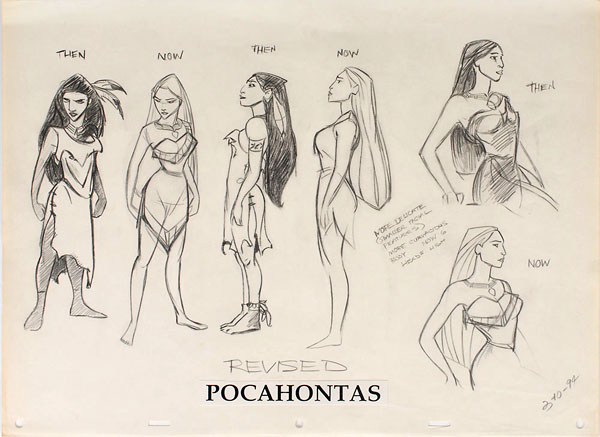
“On the film, our two greatest challenges were showing Native Americans in a positive light and women always being the victim in a Disney animated feature. Pocahontas is the most liberated. The old films were based on fairytales where the mode seems for the most part to be female as victim. Disney just followed the stories he chose.
“That’s one thing I felt with this story – in story meetings it is always talked about ‘Nope, she’s being a victim not proactive’. But Pocahontas is proactive. She saves John Smith’s life. She throws her head over his and takes an active role in the outcome. She is not sitting around in the tower waiting for someone to come help her.
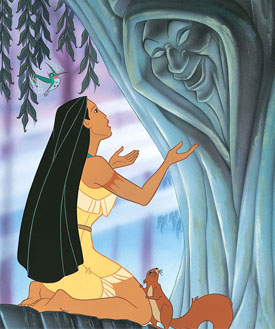 “There was some concern about the absence of a mother for Pocahontas. It is difficult because the chief would have many wives. At a certain age the daughters were taken to different aunts. John Smith’s writings don’t mention the mother role at all.
“There was some concern about the absence of a mother for Pocahontas. It is difficult because the chief would have many wives. At a certain age the daughters were taken to different aunts. John Smith’s writings don’t mention the mother role at all.
“Michael Eisner was concerned about the absence of a mother so I tried to find a solution. We had this wind in our movie. Pocahontas has a special relationship with the wind and leaves. The wind became a character in the film for a while.
“Early on I wanted the mother to be deceased and represented by a star. I asked advisor Geraldine Kemas about the spirits of rocks and trees and stars and foam. She said, ‘These are ancestors from long ago’. So I wanted to make a star be her mother. She can relate to the star and the star beam can come down and guide her.
“It didn’t fly with the executives. I tried hard. But it became this fairy godmother kind of thing. When Michael came in late in the process again talking about the mother, I brought up the star thing again. The writers liked the idea but then came back the next day and said, ‘Let’s say the wind is the mother’.
“We already had the wind come in at the last minute to help her. It was better than the star. That’s when I love the collaborative process.”
No news to anyone that all costs are rising – that includes our web hosting and plans for a much needed WordPress backend upgrade. Also, rewarding our loyal and on going contributors for their incredible work is long overdue. So, I’ve decided to open a tip jar to help defray costs. If you’ve enjoyed our posts and have found them entertaining and informative, consider throwing something in the jar. It would be very appreciated and help us continue to do even greater cartoon research for another decade. – Jerry Beck



 Jim Korkis is an internationally respected animation historian who in recent years has devoted his attention to the many worlds of Disney. He was a columnist for a variety of animation magazines. With his former writing partner, John Cawley, he authored several animation related books including The Encyclopedia of Cartoon Superstars, How to Create Animation, Cartoon Confidential and Get Animated’s Animation Art Buyer’s Guide. He taught animation classes at the Disney Institute in Florida as well as instructing classes on acting and animation history for Disney Feature Animation: Florida.
Jim Korkis is an internationally respected animation historian who in recent years has devoted his attention to the many worlds of Disney. He was a columnist for a variety of animation magazines. With his former writing partner, John Cawley, he authored several animation related books including The Encyclopedia of Cartoon Superstars, How to Create Animation, Cartoon Confidential and Get Animated’s Animation Art Buyer’s Guide. He taught animation classes at the Disney Institute in Florida as well as instructing classes on acting and animation history for Disney Feature Animation: Florida.




















































Glad to hear you’re getting better, Jim. I hope your ICU has good food, pretty nurses, and a big-screen TV for watching cartoons. Better avoid the Trans-Lux Felix the Cat show for the time being, as the side effects listed in the theme song might prove risky for cardiac patients.
Thanks for sharing this Drama-Logue interview with Mike Gabriel, which no doubt would have been recycled into toilet paper long ago had it not been for your diligence.
It’s interesting that Gabriel put so much thought into the matter of Pocahontas’s mother. As I understand it, in polygamous societies marriages are all about establishing political alliances; so if one wife dies, her children are raised, not by another wife, but by members of her own family. It’s probably for the best that the issue of polygamy was avoided altogether. It would have been just one more reason for the colonists to regard the natives as — what’s that word again? — “Savages!”
Jim I can’t begin to say how thankful I am to you for all the articles you have shared in Cartoon Research. I have learned from and enjoyed them very much. The videos I’ve watch…the books you suggested….it all has brought me so much pleasure and broadened my knowledge of the things I love: cartoons and comics. Be patient in your recovery. Listen to the doctors…and enjoy all the good things that surround you. Thank you again and get back to feeling 100% real soon! You are missed.
Wishing you a speedy and healthy recovery Jim! I continue to be inspired and amazed at your work. Thank you and my family is thinking of you as well and sends their best regards. With you always.
All Best,
Justin Byrd
I continue to be impressed and thankful that a patient undergoing heart surgery had the foresight to give Jerry the next THREE Animation Anecdotes posts! Thanks again, Jim, you are the most dedicated Cartoon Researcher I’ve ever seen or read. Best regards, Mark
Jim, I want to offer my wishes for your swift and complete recovery.
I’m very glad the operation went well; all best wishes for your recovery!
Take your time… and bear in mind that you have many loyal readers here patiently awaiting your return.
Really happy to hear Jim’s doing okay! Pretty much everyone else echo my thoughts so I offer this: whatever you decide to do once recovered, I’ll be happily following!
As for the movie itself: I honestly find the critical and audience response of the movie to be a much more interesting and fasicating tale than the movie. Seems like to many people it’s either the point of no return for 90s Disney or the one “bad apple” of the output from people my age. There is a lot to enjoy, and the interviews like these here offer some intereting insight about how the process went down. I’m hopeful that at the very least as time goes on people open up more and talk about the production more; it’s hard to determine if this was one of those productions with trauma or not. Some stories say it wasn’t, other do. Something to ponder about.
I also find it curious on how much Joe Grant’s name keep being brought up in regard’s to the movie’s production: not only is he here, but John Canemaker’s book on Joe Grant imply that of all the 90s movies, that was the one he had the most overt involvement in. Has anyone besides John done any research into that? There might be something worth looking into.
I’m glad you’re getting better, Mr. Korkis. Take your time coming back and heal up. Nothing’s more important than your health (boy, am I learning that as I get older – LOL).
Best wishes for a quick recovery, Jim.
I have so many of your books, Jim, and have benefitted greatly from your work. I hope you’re back up and running soon!